This past week, I hiked one of my favorite PNW trails - Lookout Mountain in Hood River County, Oregon. In the PNW, there is an abundance of trails that offer views, forest bathing, waterfalls, solitude, rivers, wildflowers, and cultural histories.
But the High Prairie Trail on Lookout Mountain is a favorite because:
I avoid the misery of walking up and then walking back down with 66-year-old knees. Hiking elevation gain for me involves huffing and puffing while leaning over at a 45-degree angle, slowly stepping up a thousand (or two) feet of switchbacks on the sides of mountains. Eventually, crankiness ensues, and then low-level mumbling, focused on the question, “Are we almost there?” To reach the High Prairie trail, I drive to 5900 ft elevation and then start hiking. The trail gets five stars just for that convenience.
The 3.0-mile trail starts in a flower-filled mountain meadow, meanders through sub-alpine forests of mountain hemlock, Engelmann’s spruce, lodgepole pine, white bark pine, Noble fir, and one lonely but determined Ponderosa pine.
The trail ends on a rocky knoll where the former fire lookout once existed. There’s a 360-degree view of Nature’s finest: Mount Hood to the west, Badger Creek Wilderness to the south, Mount Hood National Forest to the north, and the dramatic transition of the dark green conifer forest to brown high desert to the east. On clear days, you can see several other snow-capped volcanoes.
The mid-summer wildflowers. That’s what I come to see each year.
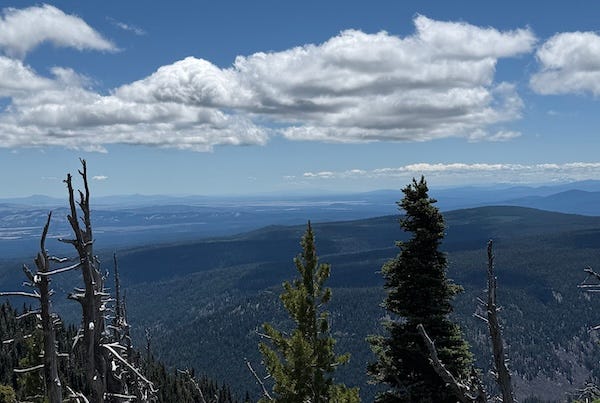

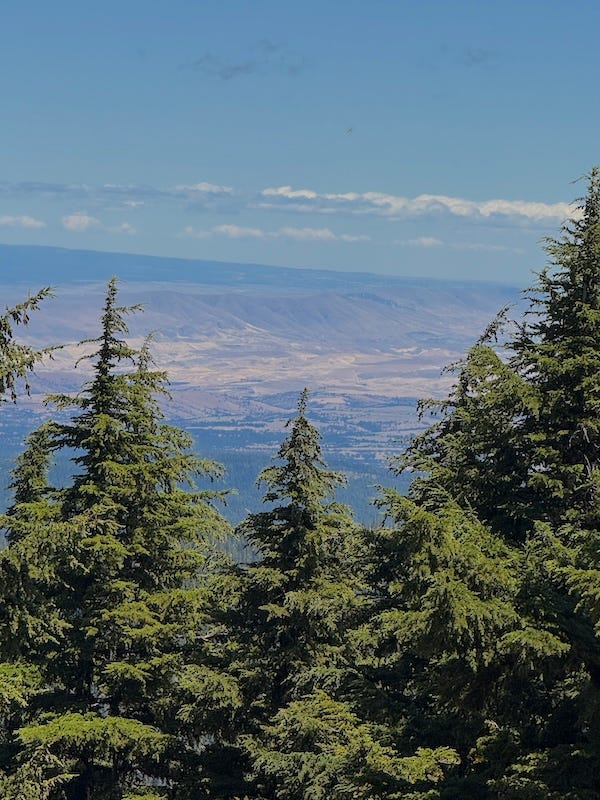
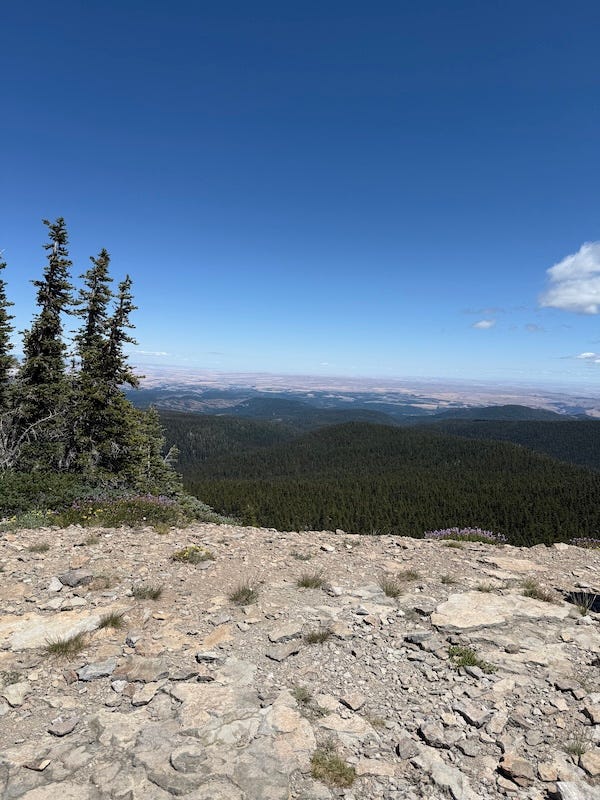
Botanical walking is a slow kind of movement, with many stops to look at every wildflower in bloom or bud. It could never be counted as cardio exercise. This particular hike also included botanical driving: the act of slowly driving a dusty, rutted Forest Service road, eyes scanning for blooming wildflowers. We need bumper stickers that warn nearby drivers: We Brake for Wildflowers.
I usually hike alone or with one companion, but this group hike is an annual tradition, co-sponsored by the Washington Native Plant Society and the Native Plant Society of Oregon. Both groups lead wildflower hikes throughout spring and summer. Our group of eleven was an impressive collection of dedicated native plant enthusiasts who knew their stuff.

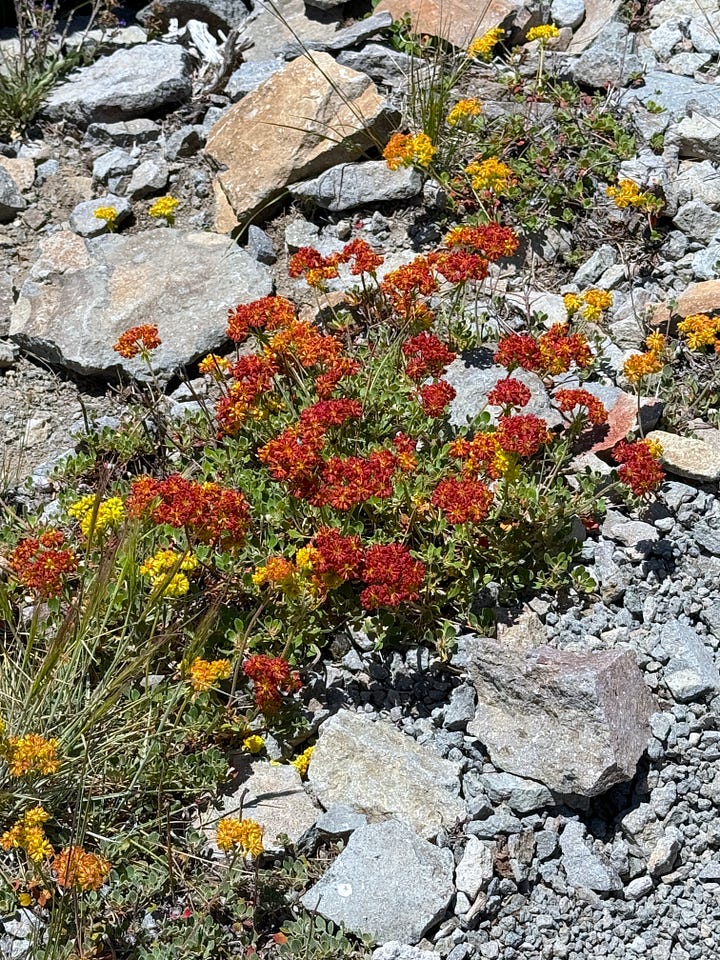

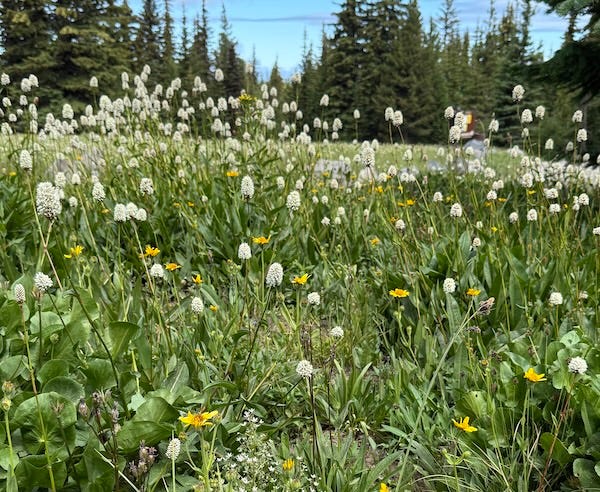
Except for me. I am not as dedicated to wildflower identification; I am there for the landscape, the beauty of nature. While the experts rolled Latin names off their tongues, I was urgently scanning the provided five-page plant list, trying to find the name, instead of admiring the wildflower. Plant people often carry clipboards with a plant inventory organized by botanical families. The most common question of the hike was “What family is it in?” It must be a botanist's ploy to force us into learning botanical classification and nomenclature.
I like to keep a record of what I see because it helps build a connection to a place. I record the species in my hiking/nature journal and spend time learning about them in various field guides. I noted that my carpool companions were checking off species on their lists, so I knew I could review their list and adjust my own on the way home.
This year, we discovered a species that we had not seen there in previous years, nor was it listed on the extensive 2014 plant list we were referencing. As we walked around a bend, we noticed a distinctive splash of purple spires just off the trail. Someone said, I think it might be Pedicularis groenlandica (common name: Elephant’s Head). A beautiful wildflower with the unfortunate older common name of Lousewort, I knew of this plant from my herbal studies, but I had never seen it in person. We looked around at the twenty or so plants thriving in the moist meadow and wondered how they found their way to this mountain.
There is also the familiarity of a trail visited annually for over a decade. Walking along a forested part of the trail, our trip leader headed off-trail to a downed tree on a steep slope. I remembered immediately: lilies grow on the side of the dead tree. I must have been hungry because I thought first of the chocolate lily, but it was dotted with glacier lilies.
Several years ago, we encountered two Oregon State graduate students who were acting suspiciously like plant enthusiasts (kneeling and heads looking down), so we stopped to ask them what they were seeing. They were delighted to explain that they were researching fungi that are revealed as snow melts and recedes in the spring and summer. None of us had heard of snowbank fungi and were fascinated. There were several patches of snow on this year’s hike, and we saw several snowbank mushrooms.
Why We Need Public Lands
Last year, when I became aware of Project 2025, the playbook for destroying America to benefit the elite, I immediately focused on the Project’s proposal for removing protections, eliminating environmental analyses, and selling the lands to private individuals and resource extractive corporations. When far-right Senator Mike Lee introduced an add-on to the Big Brutal Bill to sell a long list of our public lands to pay for part of the tax cuts to corporations and the wealthy, I called and emailed my Congressional Representatives, voicing my support for public lands to remain public. The Mount Hood area, where Lookout Mountain is, and the Columbia River Gorge (a federally protected National Scenic Area), where I live, were on the list. Thankfully, Americans spoke up loudly against selling off public lands - this time. The plan to sell public lands remains a goal for the Republican Party.1
The federal government owns 640 million acres of accessible public lands, 28% of the 2.2 billion acres of land in the US. Though a big chunk of public land acreage is in the West, every state has federally owned public lands in a variety of designations:
Forests
Monuments
Historical sites, battlefields, & memorials
National Parks, Scenic Areas, & preserves
Wildlife refuges
Conservation Areas
Recreation Areas
Wild & Scenic Rivers
National Seashores and Lakeshores
National Trails
Wilderness Areas
These lands are visited by millions of Americans each year to hike, hunt, fish, camp, study, bike, wildlife watch, ski, learn, forage, wildcraft, and paddle lakes and rivers. Tourists from all over the world visit our well-known national parks, and over the last three decades, outdoor recreation has become a significant factor in the US economy. In addition to generating billions of dollars in revenue each year for the federal government, the public lands economy supports millions of employees in related fields and small businesses in rural areas.

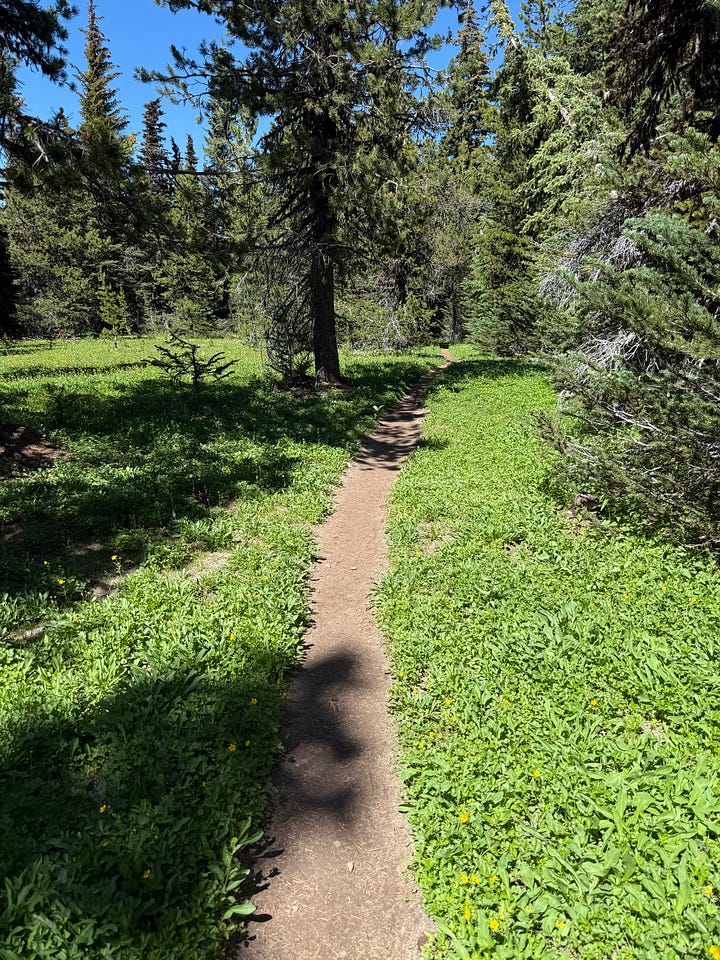
In 2023, the total amount spent by Americans on all things outdoor recreation contributed $639.5 billion to the U.S. economy—or 2.3 percent of the nation’s GDP, according to the U.S. Bureau of Economic Analysis. 2
More importantly, public lands are the last refuge for many of our native flora and fauna. We must do everything we can to protect Nature. That’s partly why I chase wildflowers; I want to know who they are, where they live, and what their ecological relationships are. We also must honor the cultural and spiritual heritage of Native people. So far, our record on honoring their historical relationship with place and land is lousy.
In a July 6, 2025, NYT op-ed, writer and activist Terri Tempest Williams wrote:
Public lands are our public commons, breathing spaces in a country that is increasingly holding its breath. There we are free to roam and wander and believe in what we see: rock, water, sky; pronghorn in sagebrush, eagles in flight, a night sky of stars above a silhouette of mountains. These are places of peace and renewal, where landscapes of beauty become landscapes of our imaginations. We stand before a giant sequoia and remember the size of our hearts instead of the weight of our egos.
If we allow these lands to be developed in the name of profits, we will lose the wide-open spaces that define us as Americans.3
Several times on the six-hour botanical walk, I moved ahead of the group to stand alone in the meadow and forest to take in the silence and the natural beauty. My emotions responded immediately: I experienced a deep sense of peace, wonder, and awe - a connection to the mountainous forested landscape. Several days later, the subalpine landscape interrupts my busy brain with peaceful images. German psychologist Erich Fromm and American biologist E.O. Wilson developed the term biophilia to describe humans’ inherent need to connect with nature. I prefer the Finnish language, which calls this brain-landscape connection silunmaisema, best translated as the “landscape of the soul.”
Thank you for being here. All of my posts are free, but if you’d like to support my work, you can do so by:
Liking and restacking this post so others are encouraged to read it.
Share this post via email or on social media.
Taking out a paid subscription to this Substack.
Do you have a landscape of the soul? How does it make you feel?
https://www.hcn.org/articles/project-2025s-extreme-vision-for-the-west/
https://bettertrail.com/public-lands/the-outdoor-recreation-economy





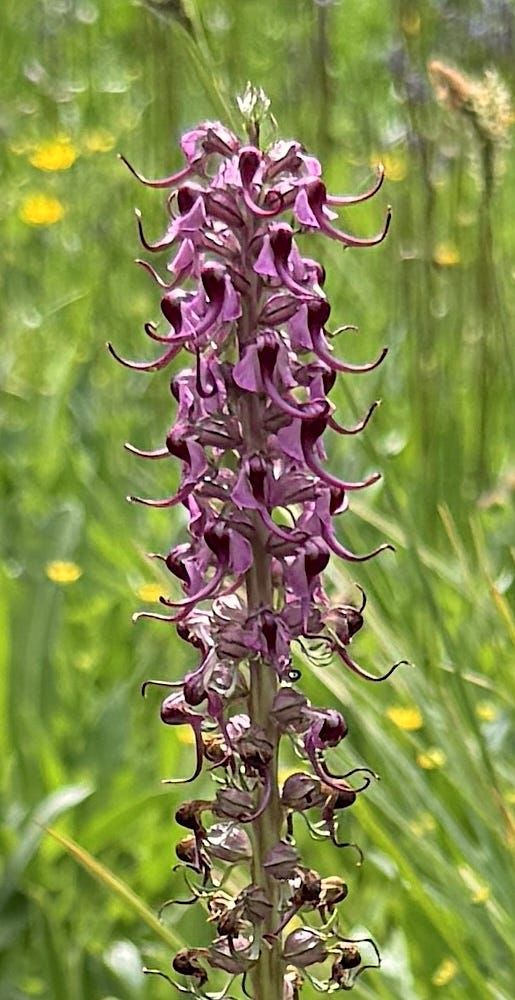
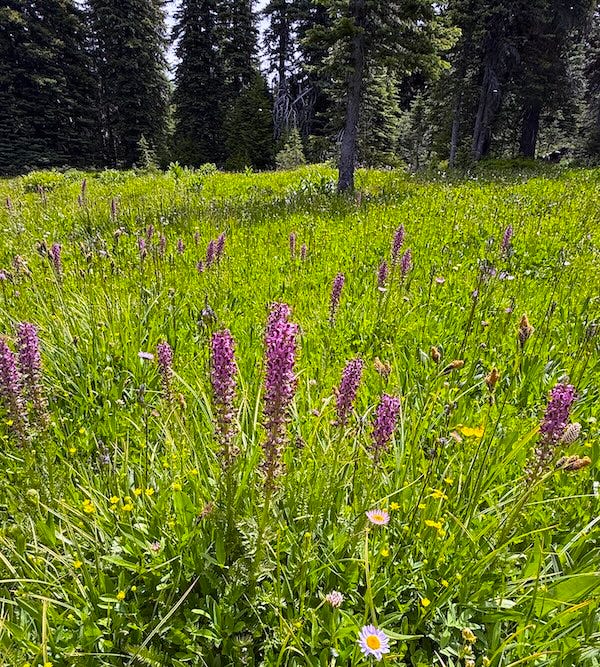
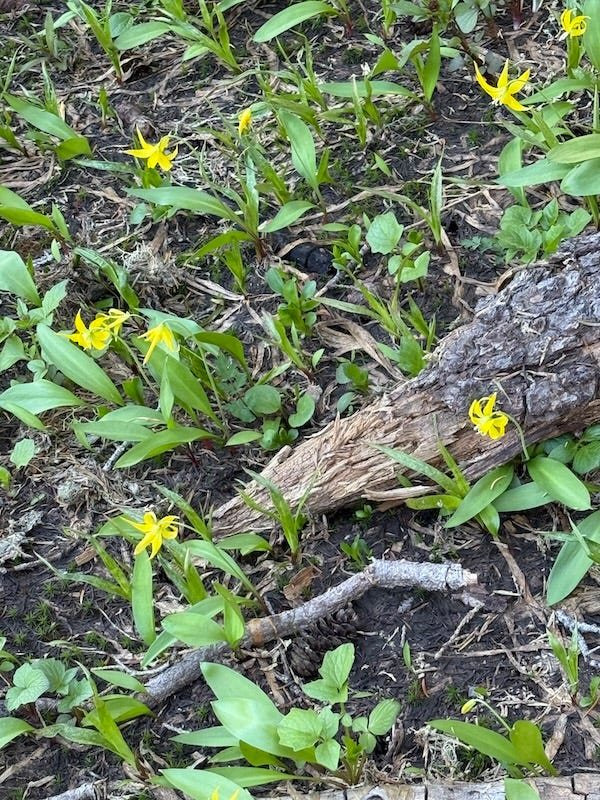
I love that the three mile hike took six hours! Of course, with a group like this, and such devoted attention to their lists, that’s not surprising. My typical pace on meanders the woods is about a mile an hour: three hours for a 3 mile hike, five hours for a 5 mile hike. Some of this is “slow walking“ practice, but most of it is a readiness/eagerness to pause and soak up details or the big picture along the way. In a new landscape, this might also transfer to driving, so that, eg, a 70 drive takes seven hours, thanks to countless 3 to 30ish minute pauses along the way….. a couple memorable day drives like this were from Lone Pine through the Panamint Valley and a full day in the TNC tallgrass prairie preserve in Oklahoma (SO highly recommended!), where the 50 mi/5hr drive was broken up by a 3mi/3hr intermission on a trail—a perfect day!
As a botanist (plant ecologist), I welcome the exploration of plants in whatever guise. Your walk sounds wonderful.
I can even enjoy the naturalized meadows that make up the roadsides and grasslands here in Eastern Quebec; not native, but beautiful, nonetheless.